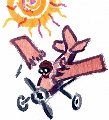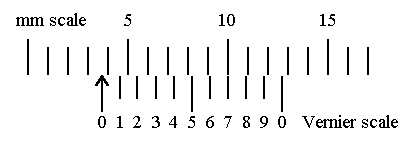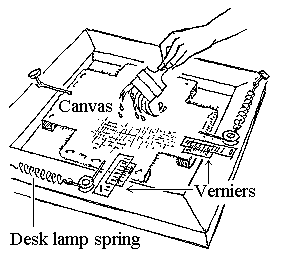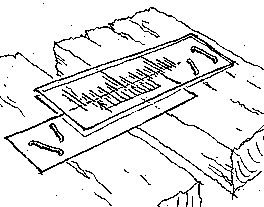
 |
Measuring stress and strain |
The simplest device for measuring strain is a ruler. The vernier is a device for increasing the accuracy of the ruler about ten times. The simple pointer that marks the position of the object moving along the line of the ruler is extended with a series of marks that are nine tenths as far apart as the marks on the ruler. The picture below illustrates the process.

The exact position of the arrow between the millimetre marks is given by the number of the mark on the vernier scale that coincides with any mark on the millimetre scale. The measurement in this case is 3.7 mm.
If you don't understand this, try playing with the moving vernier applet!

The vernier principle has many uses in conservation research and surveillance. The sketch shows an experiment to measure the biaxial stress-strain performance of canvas. This construction was tested in a five day course at the Copenhagen Conservation School. Given the appalling instability and variability of canvas the results are just as useful as those made with elaborate mechanical and electronic apparatus.
Lamination of one material to another is a frequent operation in conservation, particularly of textiles, paintings and paper. Distressingly often one can see at a glance that the material chosen to reinforce an object is more extensible than the object and is therefore simply adding weight, providing no support but giving the illusion that the object can be handled more robustly.
It is quite feasible to set up a simple apparatus in the conservation workshop to study, quantitatively, the likely mechanical result of a suggested treatment. Conservators are very diligent in studying the performance of various varnishes, adhesives and other chemical treatments but are strangely reluctant to tackle mechanical aspects of conservation treatment.
Verniers can be made by photographing a scale at two magnifications, one nine tenths of the other, onto polyester base high contrast film. Nowadays an office copier with zoom will give almost as good results on transparency film.

In real life things seldom move smoothly past each other but tend to warp and twist at the same time. Parallax error can entirely wreck the precision of the vernier. The problem can be eased by fixing two millimetre scales exactly over one another. The vernier part slides between them so that the eye can detect the alignment of all three lines.
There are many variations on the theme of measurement by lines coming into coincidence. Moire patterns, resulting from the periodic coincidence of two sets of parallel lines superimposed with a small angle between them, allow the measurement of tiny rotations, for example. One could imagine a fine net of lines printed over a whole canvas, with a matching pattern on an inextensible plastic overlay. But one would not want to spoil the fun of people doing the same sort of thing with holographic laser interferometry.
Some experiments take a long time and need automating.
The next section looks at the electronic strain gauge.

This work is licensed under a Creative Commons Attribution-Noncommercial-No Derivative Works 3.0 License.